Australian Government – Department of Social Services Assignment PDF
VerifiedAdded on 2021/08/03
|11
|3565
|111
AI Summary
Contribute Materials
Your contribution can guide someone’s learning journey. Share your
documents today.
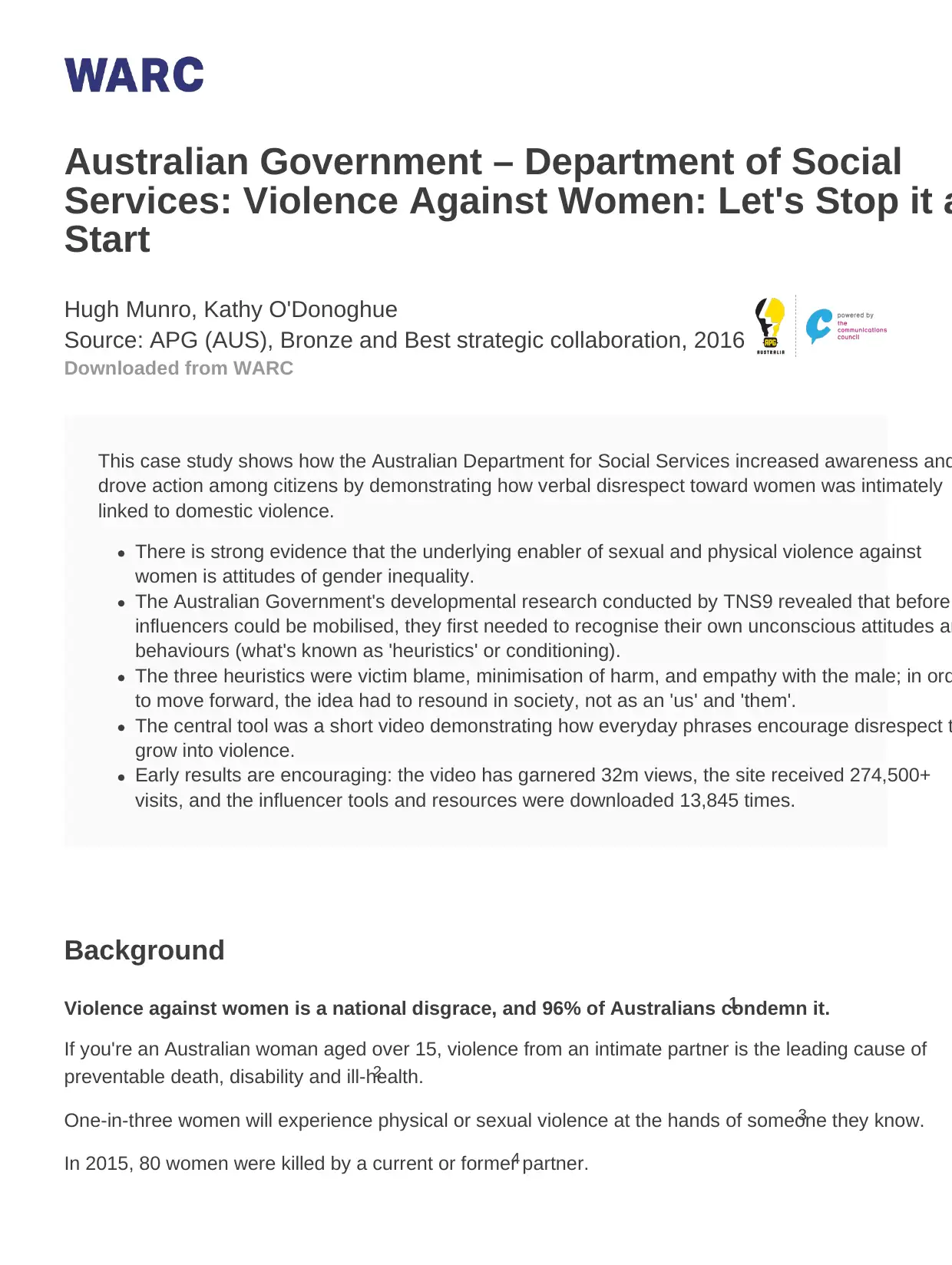
Hugh Munro, Kathy O'Donoghue
Source: APG (AUS), Bronze and Best strategic collaboration, 2016
Downloaded from WARC
Australian Government – Department of Social
Services: Violence Against Women: Let's Stop it a
Start
This case study shows how the Australian Department for Social Services increased awareness and
drove action among citizens by demonstrating how verbal disrespect toward women was intimately
linked to domestic violence.
There is strong evidence that the underlying enabler of sexual and physical violence against
women is attitudes of gender inequality.
The Australian Government's developmental research conducted by TNS9 revealed that before
influencers could be mobilised, they first needed to recognise their own unconscious attitudes an
behaviours (what's known as 'heuristics' or conditioning).
The three heuristics were victim blame, minimisation of harm, and empathy with the male; in ord
to move forward, the idea had to resound in society, not as an 'us' and 'them'.
The central tool was a short video demonstrating how everyday phrases encourage disrespect t
grow into violence.
Early results are encouraging: the video has garnered 32m views, the site received 274,500+
visits, and the influencer tools and resources were downloaded 13,845 times.
Background
Violence against women is a national disgrace, and 96% of Australians condemn it.1
If you're an Australian woman aged over 15, violence from an intimate partner is the leading cause of
preventable death, disability and ill-health.2
One-in-three women will experience physical or sexual violence at the hands of someone they know.3
In 2015, 80 women were killed by a current or former partner.4
Source: APG (AUS), Bronze and Best strategic collaboration, 2016
Downloaded from WARC
Australian Government – Department of Social
Services: Violence Against Women: Let's Stop it a
Start
This case study shows how the Australian Department for Social Services increased awareness and
drove action among citizens by demonstrating how verbal disrespect toward women was intimately
linked to domestic violence.
There is strong evidence that the underlying enabler of sexual and physical violence against
women is attitudes of gender inequality.
The Australian Government's developmental research conducted by TNS9 revealed that before
influencers could be mobilised, they first needed to recognise their own unconscious attitudes an
behaviours (what's known as 'heuristics' or conditioning).
The three heuristics were victim blame, minimisation of harm, and empathy with the male; in ord
to move forward, the idea had to resound in society, not as an 'us' and 'them'.
The central tool was a short video demonstrating how everyday phrases encourage disrespect t
grow into violence.
Early results are encouraging: the video has garnered 32m views, the site received 274,500+
visits, and the influencer tools and resources were downloaded 13,845 times.
Background
Violence against women is a national disgrace, and 96% of Australians condemn it.1
If you're an Australian woman aged over 15, violence from an intimate partner is the leading cause of
preventable death, disability and ill-health.2
One-in-three women will experience physical or sexual violence at the hands of someone they know.3
In 2015, 80 women were killed by a current or former partner.4
Secure Best Marks with AI Grader
Need help grading? Try our AI Grader for instant feedback on your assignments.
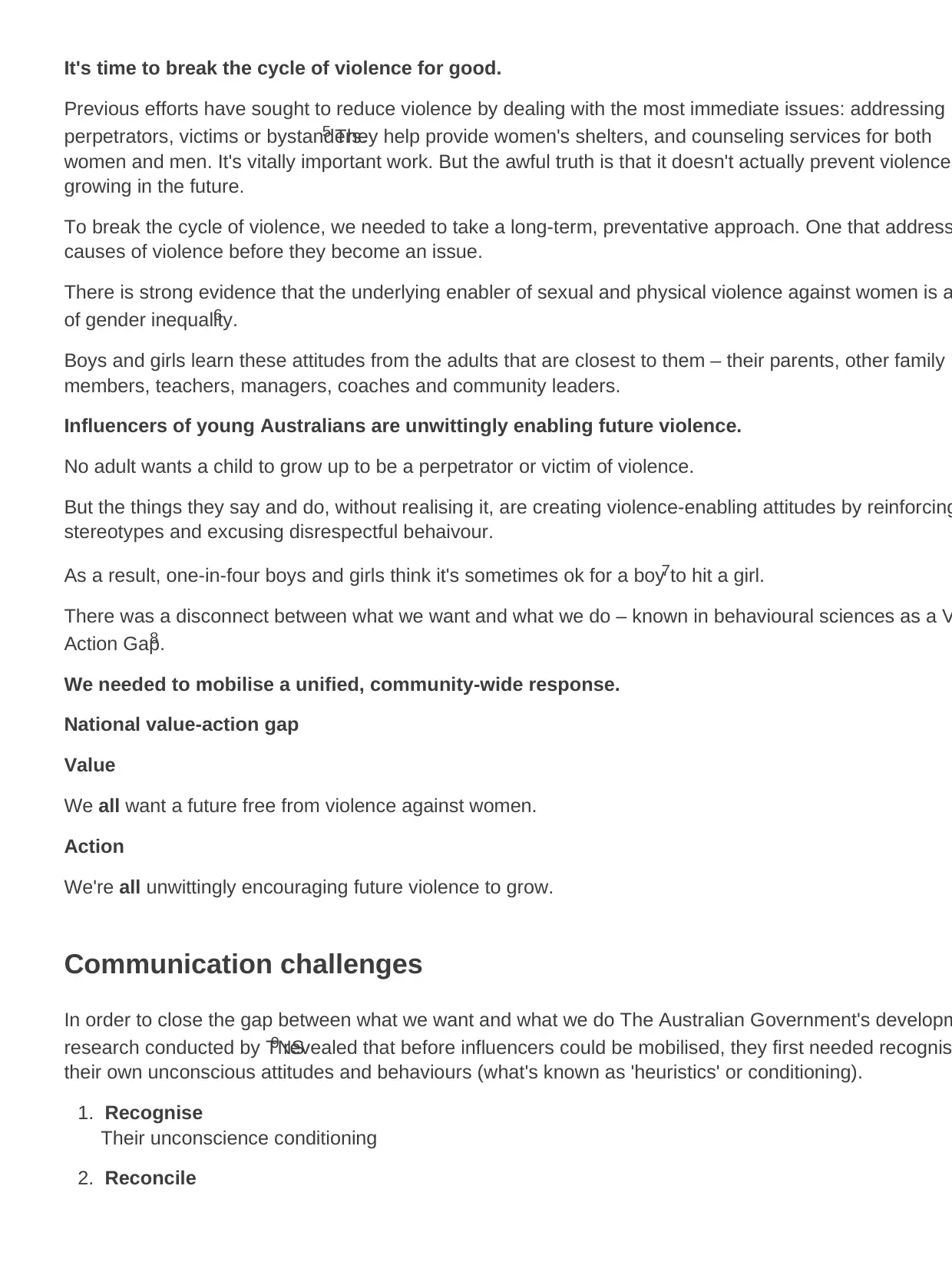
It's time to break the cycle of violence for good.
Previous efforts have sought to reduce violence by dealing with the most immediate issues: addressing
perpetrators, victims or bystanders.5 They help provide women's shelters, and counseling services for both
women and men. It's vitally important work. But the awful truth is that it doesn't actually prevent violence
growing in the future.
To break the cycle of violence, we needed to take a long-term, preventative approach. One that address
causes of violence before they become an issue.
There is strong evidence that the underlying enabler of sexual and physical violence against women is a
of gender inequality.6
Boys and girls learn these attitudes from the adults that are closest to them – their parents, other family
members, teachers, managers, coaches and community leaders.
Influencers of young Australians are unwittingly enabling future violence.
No adult wants a child to grow up to be a perpetrator or victim of violence.
But the things they say and do, without realising it, are creating violence-enabling attitudes by reinforcing
stereotypes and excusing disrespectful behaivour.
As a result, one-in-four boys and girls think it's sometimes ok for a boy to hit a girl.7
There was a disconnect between what we want and what we do – known in behavioural sciences as a V
Action Gap.8
We needed to mobilise a unified, community-wide response.
National value-action gap
Value
We all want a future free from violence against women.
Action
We're all unwittingly encouraging future violence to grow.
Communication challenges
In order to close the gap between what we want and what we do The Australian Government's developm
research conducted by TNS9 revealed that before influencers could be mobilised, they first needed recognis
their own unconscious attitudes and behaviours (what's known as 'heuristics' or conditioning).
1. Recognise
Their unconscience conditioning
2. Reconcile
Previous efforts have sought to reduce violence by dealing with the most immediate issues: addressing
perpetrators, victims or bystanders.5 They help provide women's shelters, and counseling services for both
women and men. It's vitally important work. But the awful truth is that it doesn't actually prevent violence
growing in the future.
To break the cycle of violence, we needed to take a long-term, preventative approach. One that address
causes of violence before they become an issue.
There is strong evidence that the underlying enabler of sexual and physical violence against women is a
of gender inequality.6
Boys and girls learn these attitudes from the adults that are closest to them – their parents, other family
members, teachers, managers, coaches and community leaders.
Influencers of young Australians are unwittingly enabling future violence.
No adult wants a child to grow up to be a perpetrator or victim of violence.
But the things they say and do, without realising it, are creating violence-enabling attitudes by reinforcing
stereotypes and excusing disrespectful behaivour.
As a result, one-in-four boys and girls think it's sometimes ok for a boy to hit a girl.7
There was a disconnect between what we want and what we do – known in behavioural sciences as a V
Action Gap.8
We needed to mobilise a unified, community-wide response.
National value-action gap
Value
We all want a future free from violence against women.
Action
We're all unwittingly encouraging future violence to grow.
Communication challenges
In order to close the gap between what we want and what we do The Australian Government's developm
research conducted by TNS9 revealed that before influencers could be mobilised, they first needed recognis
their own unconscious attitudes and behaviours (what's known as 'heuristics' or conditioning).
1. Recognise
Their unconscience conditioning
2. Reconcile
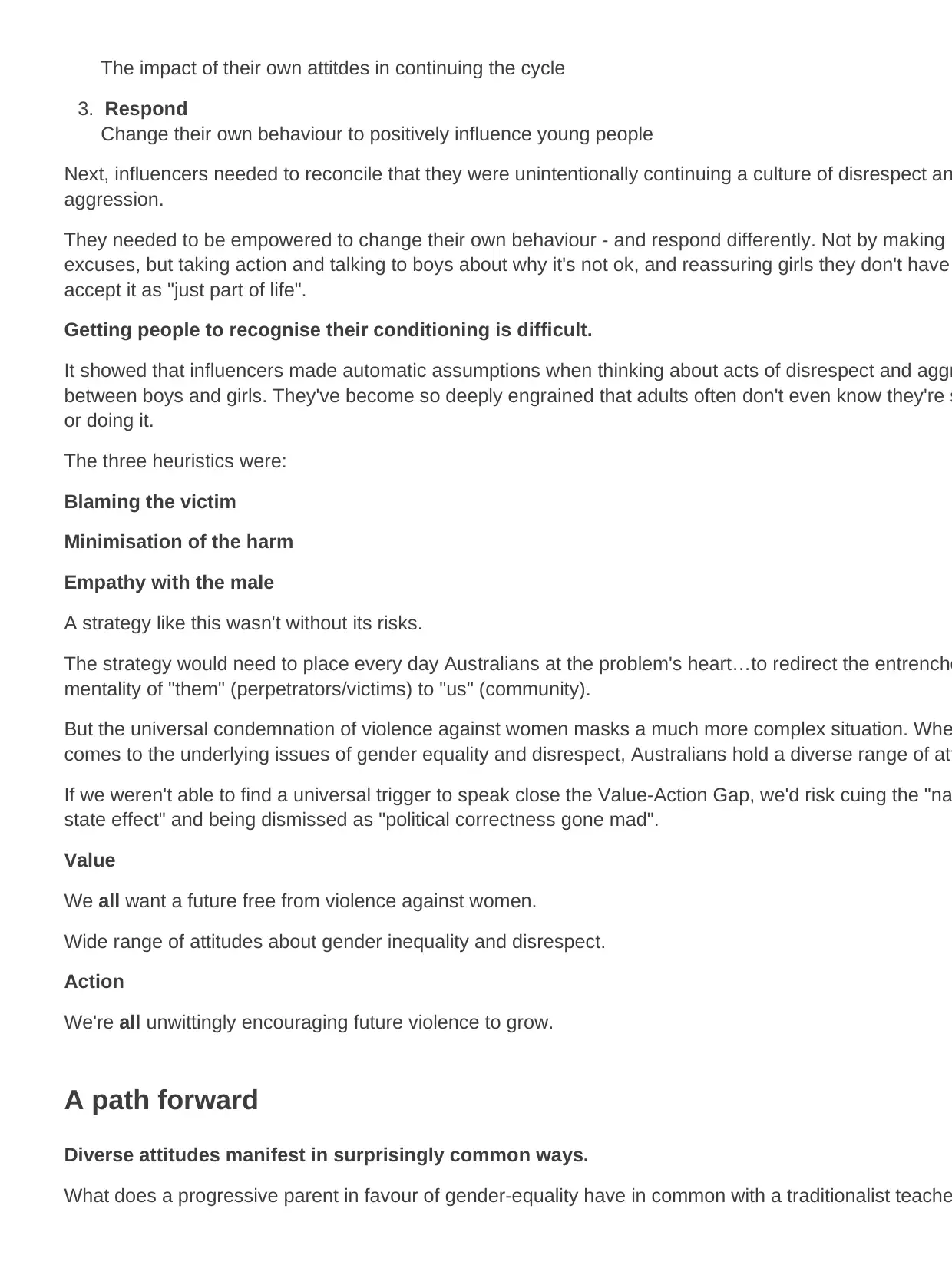
The impact of their own attitdes in continuing the cycle
3. Respond
Change their own behaviour to positively influence young people
Next, influencers needed to reconcile that they were unintentionally continuing a culture of disrespect an
aggression.
They needed to be empowered to change their own behaviour - and respond differently. Not by making
excuses, but taking action and talking to boys about why it's not ok, and reassuring girls they don't have
accept it as "just part of life".
Getting people to recognise their conditioning is difficult.
It showed that influencers made automatic assumptions when thinking about acts of disrespect and aggr
between boys and girls. They've become so deeply engrained that adults often don't even know they're s
or doing it.
The three heuristics were:
Blaming the victim
Minimisation of the harm
Empathy with the male
A strategy like this wasn't without its risks.
The strategy would need to place every day Australians at the problem's heart…to redirect the entrenche
mentality of "them" (perpetrators/victims) to "us" (community).
But the universal condemnation of violence against women masks a much more complex situation. Whe
comes to the underlying issues of gender equality and disrespect, Australians hold a diverse range of att
If we weren't able to find a universal trigger to speak close the Value-Action Gap, we'd risk cuing the "na
state effect" and being dismissed as "political correctness gone mad".
Value
We all want a future free from violence against women.
Wide range of attitudes about gender inequality and disrespect.
Action
We're all unwittingly encouraging future violence to grow.
A path forward
Diverse attitudes manifest in surprisingly common ways.
What does a progressive parent in favour of gender-equality have in common with a traditionalist teache
3. Respond
Change their own behaviour to positively influence young people
Next, influencers needed to reconcile that they were unintentionally continuing a culture of disrespect an
aggression.
They needed to be empowered to change their own behaviour - and respond differently. Not by making
excuses, but taking action and talking to boys about why it's not ok, and reassuring girls they don't have
accept it as "just part of life".
Getting people to recognise their conditioning is difficult.
It showed that influencers made automatic assumptions when thinking about acts of disrespect and aggr
between boys and girls. They've become so deeply engrained that adults often don't even know they're s
or doing it.
The three heuristics were:
Blaming the victim
Minimisation of the harm
Empathy with the male
A strategy like this wasn't without its risks.
The strategy would need to place every day Australians at the problem's heart…to redirect the entrenche
mentality of "them" (perpetrators/victims) to "us" (community).
But the universal condemnation of violence against women masks a much more complex situation. Whe
comes to the underlying issues of gender equality and disrespect, Australians hold a diverse range of att
If we weren't able to find a universal trigger to speak close the Value-Action Gap, we'd risk cuing the "na
state effect" and being dismissed as "political correctness gone mad".
Value
We all want a future free from violence against women.
Wide range of attitudes about gender inequality and disrespect.
Action
We're all unwittingly encouraging future violence to grow.
A path forward
Diverse attitudes manifest in surprisingly common ways.
What does a progressive parent in favour of gender-equality have in common with a traditionalist teache
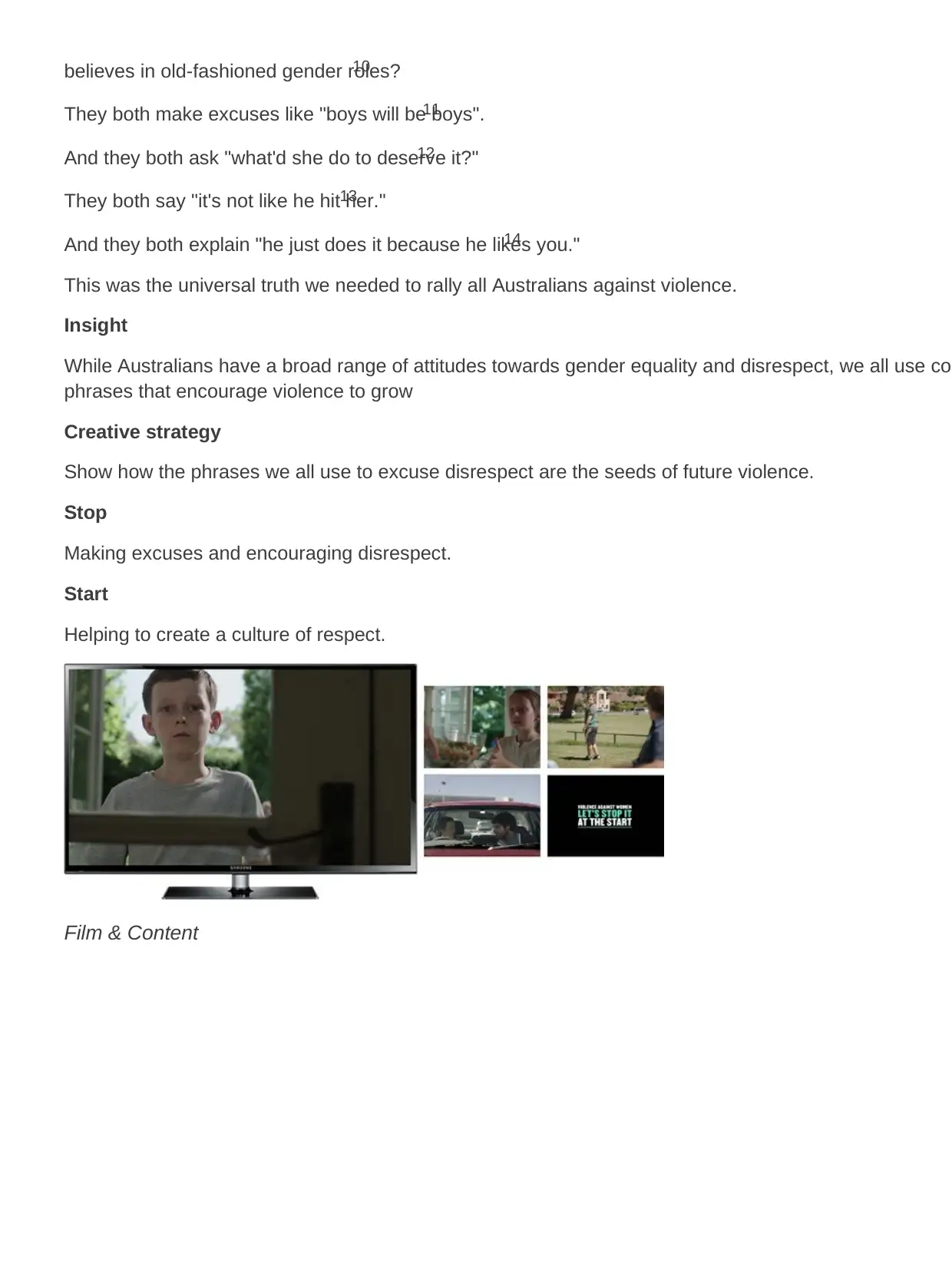
believes in old-fashioned gender roles?10
They both make excuses like "boys will be boys".11
And they both ask "what'd she do to deserve it?"12
They both say "it's not like he hit her."13
And they both explain "he just does it because he likes you."14
This was the universal truth we needed to rally all Australians against violence.
Insight
While Australians have a broad range of attitudes towards gender equality and disrespect, we all use com
phrases that encourage violence to grow
Creative strategy
Show how the phrases we all use to excuse disrespect are the seeds of future violence.
Stop
Making excuses and encouraging disrespect.
Start
Helping to create a culture of respect.
Film & Content
They both make excuses like "boys will be boys".11
And they both ask "what'd she do to deserve it?"12
They both say "it's not like he hit her."13
And they both explain "he just does it because he likes you."14
This was the universal truth we needed to rally all Australians against violence.
Insight
While Australians have a broad range of attitudes towards gender equality and disrespect, we all use com
phrases that encourage violence to grow
Creative strategy
Show how the phrases we all use to excuse disrespect are the seeds of future violence.
Stop
Making excuses and encouraging disrespect.
Start
Helping to create a culture of respect.
Film & Content
Secure Best Marks with AI Grader
Need help grading? Try our AI Grader for instant feedback on your assignments.
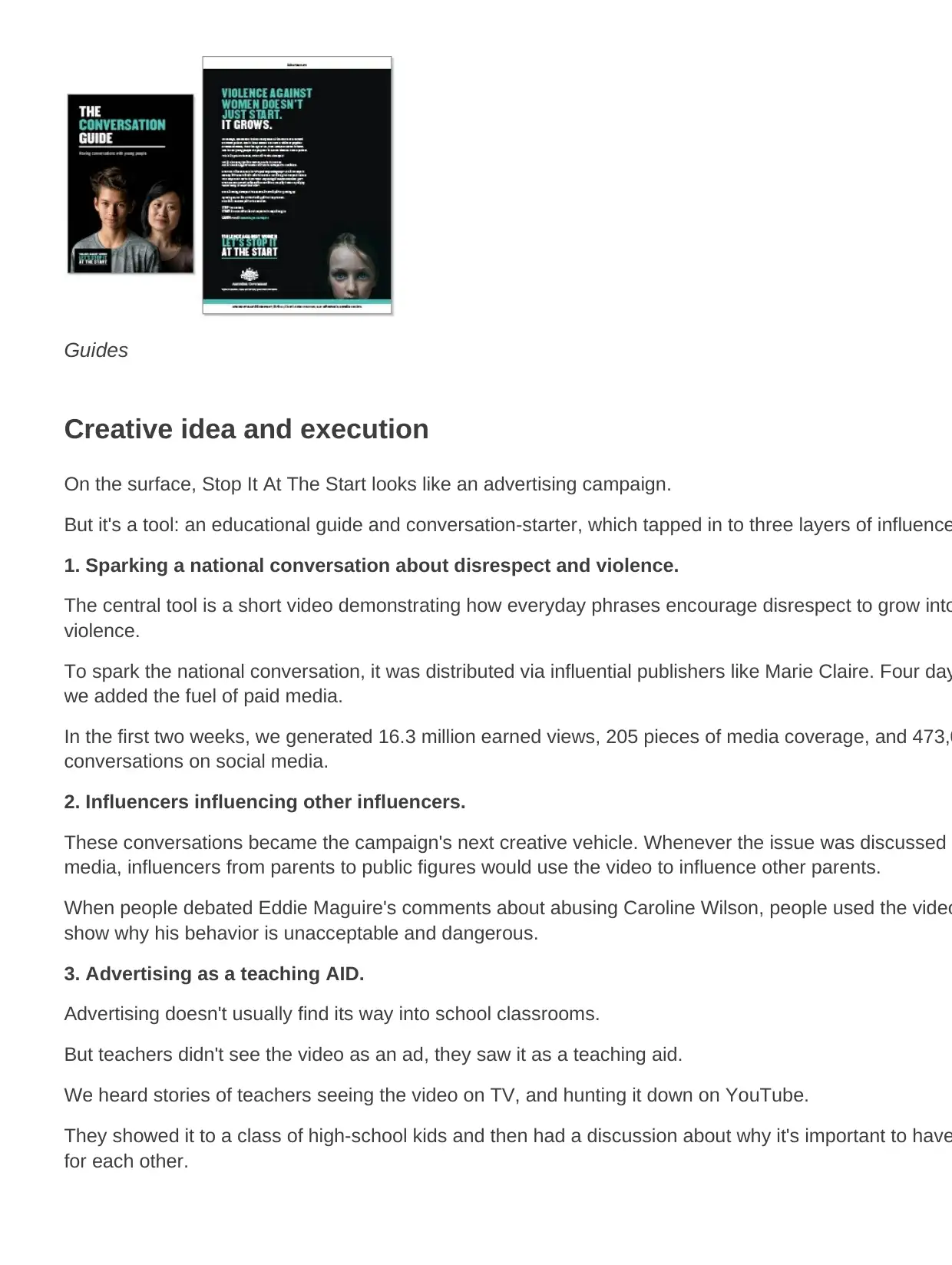
Guides
Creative idea and execution
On the surface, Stop It At The Start looks like an advertising campaign.
But it's a tool: an educational guide and conversation-starter, which tapped in to three layers of influence
1. Sparking a national conversation about disrespect and violence.
The central tool is a short video demonstrating how everyday phrases encourage disrespect to grow into
violence.
To spark the national conversation, it was distributed via influential publishers like Marie Claire. Four day
we added the fuel of paid media.
In the first two weeks, we generated 16.3 million earned views, 205 pieces of media coverage, and 473,0
conversations on social media.
2. Influencers influencing other influencers.
These conversations became the campaign's next creative vehicle. Whenever the issue was discussed
media, influencers from parents to public figures would use the video to influence other parents.
When people debated Eddie Maguire's comments about abusing Caroline Wilson, people used the video
show why his behavior is unacceptable and dangerous.
3. Advertising as a teaching AID.
Advertising doesn't usually find its way into school classrooms.
But teachers didn't see the video as an ad, they saw it as a teaching aid.
We heard stories of teachers seeing the video on TV, and hunting it down on YouTube.
They showed it to a class of high-school kids and then had a discussion about why it's important to have
for each other.
Creative idea and execution
On the surface, Stop It At The Start looks like an advertising campaign.
But it's a tool: an educational guide and conversation-starter, which tapped in to three layers of influence
1. Sparking a national conversation about disrespect and violence.
The central tool is a short video demonstrating how everyday phrases encourage disrespect to grow into
violence.
To spark the national conversation, it was distributed via influential publishers like Marie Claire. Four day
we added the fuel of paid media.
In the first two weeks, we generated 16.3 million earned views, 205 pieces of media coverage, and 473,0
conversations on social media.
2. Influencers influencing other influencers.
These conversations became the campaign's next creative vehicle. Whenever the issue was discussed
media, influencers from parents to public figures would use the video to influence other parents.
When people debated Eddie Maguire's comments about abusing Caroline Wilson, people used the video
show why his behavior is unacceptable and dangerous.
3. Advertising as a teaching AID.
Advertising doesn't usually find its way into school classrooms.
But teachers didn't see the video as an ad, they saw it as a teaching aid.
We heard stories of teachers seeing the video on TV, and hunting it down on YouTube.
They showed it to a class of high-school kids and then had a discussion about why it's important to have
for each other.
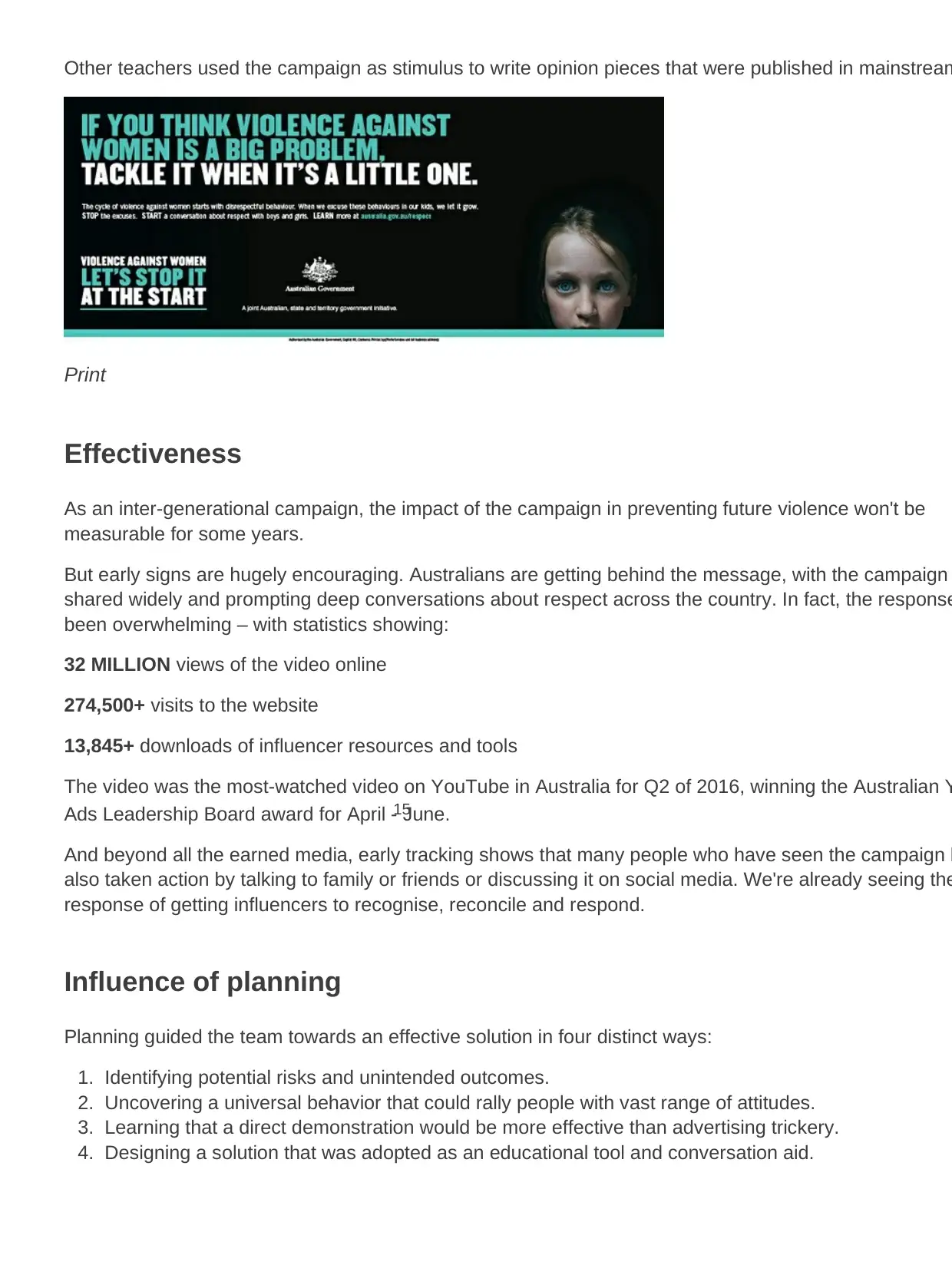
Other teachers used the campaign as stimulus to write opinion pieces that were published in mainstream
Print
Effectiveness
As an inter-generational campaign, the impact of the campaign in preventing future violence won't be
measurable for some years.
But early signs are hugely encouraging. Australians are getting behind the message, with the campaign
shared widely and prompting deep conversations about respect across the country. In fact, the response
been overwhelming – with statistics showing:
32 MILLION views of the video online
274,500+ visits to the website
13,845+ downloads of influencer resources and tools
The video was the most-watched video on YouTube in Australia for Q2 of 2016, winning the Australian Y
Ads Leadership Board award for April - June.15
And beyond all the earned media, early tracking shows that many people who have seen the campaign h
also taken action by talking to family or friends or discussing it on social media. We're already seeing the
response of getting influencers to recognise, reconcile and respond.
Influence of planning
Planning guided the team towards an effective solution in four distinct ways:
1. Identifying potential risks and unintended outcomes.
2. Uncovering a universal behavior that could rally people with vast range of attitudes.
3. Learning that a direct demonstration would be more effective than advertising trickery.
4. Designing a solution that was adopted as an educational tool and conversation aid.
Effectiveness
As an inter-generational campaign, the impact of the campaign in preventing future violence won't be
measurable for some years.
But early signs are hugely encouraging. Australians are getting behind the message, with the campaign
shared widely and prompting deep conversations about respect across the country. In fact, the response
been overwhelming – with statistics showing:
32 MILLION views of the video online
274,500+ visits to the website
13,845+ downloads of influencer resources and tools
The video was the most-watched video on YouTube in Australia for Q2 of 2016, winning the Australian Y
Ads Leadership Board award for April - June.15
And beyond all the earned media, early tracking shows that many people who have seen the campaign h
also taken action by talking to family or friends or discussing it on social media. We're already seeing the
response of getting influencers to recognise, reconcile and respond.
Influence of planning
Planning guided the team towards an effective solution in four distinct ways:
1. Identifying potential risks and unintended outcomes.
2. Uncovering a universal behavior that could rally people with vast range of attitudes.
3. Learning that a direct demonstration would be more effective than advertising trickery.
4. Designing a solution that was adopted as an educational tool and conversation aid.
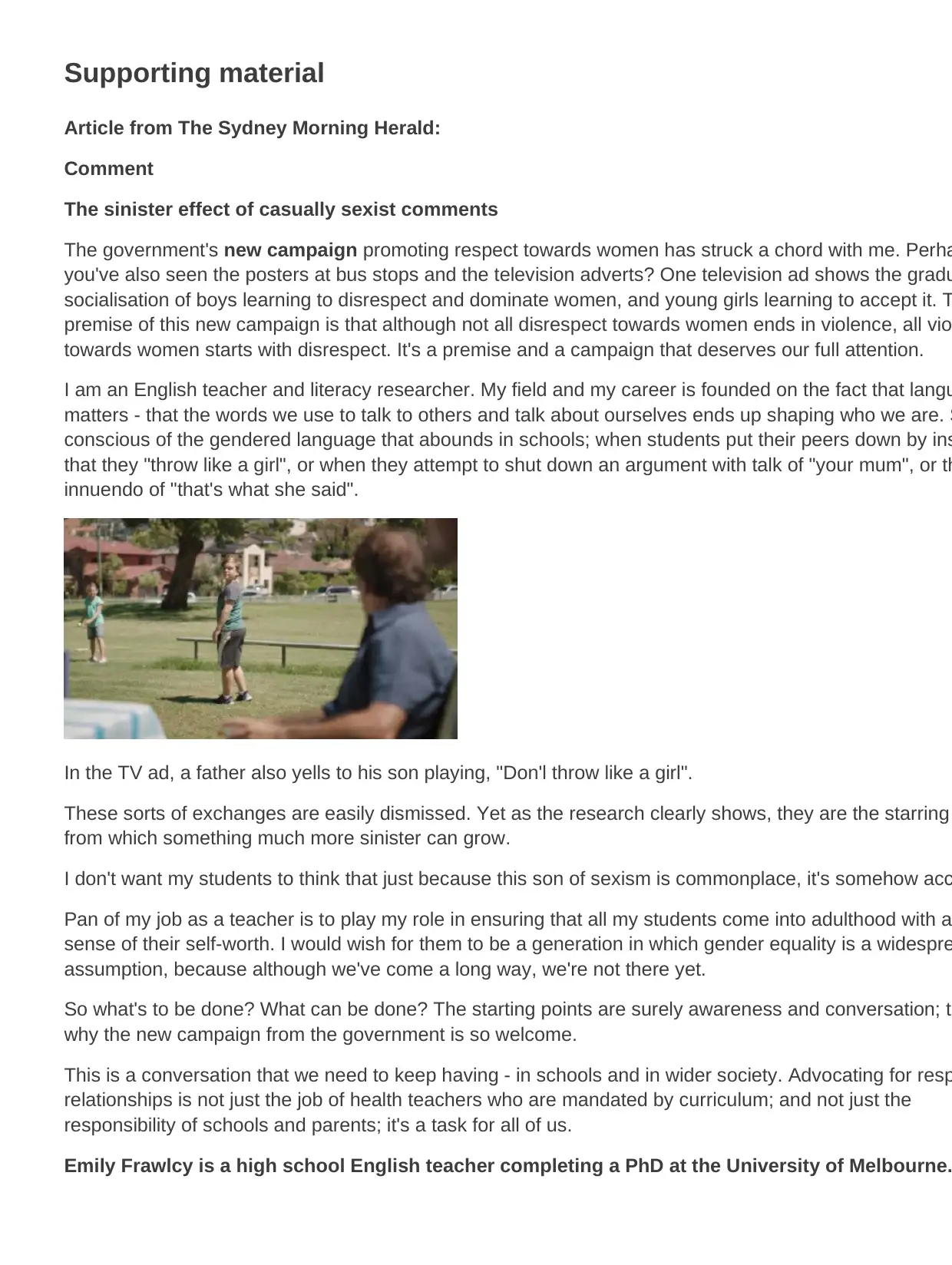
Supporting material
Article from The Sydney Morning Herald:
Comment
The sinister effect of casually sexist comments
The government's new campaign promoting respect towards women has struck a chord with me. Perha
you've also seen the posters at bus stops and the television adverts? One television ad shows the gradu
socialisation of boys learning to disrespect and dominate women, and young girls learning to accept it. T
premise of this new campaign is that although not all disrespect towards women ends in violence, all vio
towards women starts with disrespect. It's a premise and a campaign that deserves our full attention.
I am an English teacher and literacy researcher. My field and my career is founded on the fact that langu
matters - that the words we use to talk to others and talk about ourselves ends up shaping who we are. S
conscious of the gendered language that abounds in schools; when students put their peers down by ins
that they "throw like a girl", or when they attempt to shut down an argument with talk of "your mum", or th
innuendo of "that's what she said".
In the TV ad, a father also yells to his son playing, "Don'l throw like a girl".
These sorts of exchanges are easily dismissed. Yet as the research clearly shows, they are the starring
from which something much more sinister can grow.
I don't want my students to think that just because this son of sexism is commonplace, it's somehow acc
Pan of my job as a teacher is to play my role in ensuring that all my students come into adulthood with a
sense of their self-worth. I would wish for them to be a generation in which gender equality is a widespre
assumption, because although we've come a long way, we're not there yet.
So what's to be done? What can be done? The starting points are surely awareness and conversation; th
why the new campaign from the government is so welcome.
This is a conversation that we need to keep having - in schools and in wider society. Advocating for resp
relationships is not just the job of health teachers who are mandated by curriculum; and not just the
responsibility of schools and parents; it's a task for all of us.
Emily Frawlcy is a high school English teacher completing a PhD at the University of Melbourne.
Article from The Sydney Morning Herald:
Comment
The sinister effect of casually sexist comments
The government's new campaign promoting respect towards women has struck a chord with me. Perha
you've also seen the posters at bus stops and the television adverts? One television ad shows the gradu
socialisation of boys learning to disrespect and dominate women, and young girls learning to accept it. T
premise of this new campaign is that although not all disrespect towards women ends in violence, all vio
towards women starts with disrespect. It's a premise and a campaign that deserves our full attention.
I am an English teacher and literacy researcher. My field and my career is founded on the fact that langu
matters - that the words we use to talk to others and talk about ourselves ends up shaping who we are. S
conscious of the gendered language that abounds in schools; when students put their peers down by ins
that they "throw like a girl", or when they attempt to shut down an argument with talk of "your mum", or th
innuendo of "that's what she said".
In the TV ad, a father also yells to his son playing, "Don'l throw like a girl".
These sorts of exchanges are easily dismissed. Yet as the research clearly shows, they are the starring
from which something much more sinister can grow.
I don't want my students to think that just because this son of sexism is commonplace, it's somehow acc
Pan of my job as a teacher is to play my role in ensuring that all my students come into adulthood with a
sense of their self-worth. I would wish for them to be a generation in which gender equality is a widespre
assumption, because although we've come a long way, we're not there yet.
So what's to be done? What can be done? The starting points are surely awareness and conversation; th
why the new campaign from the government is so welcome.
This is a conversation that we need to keep having - in schools and in wider society. Advocating for resp
relationships is not just the job of health teachers who are mandated by curriculum; and not just the
responsibility of schools and parents; it's a task for all of us.
Emily Frawlcy is a high school English teacher completing a PhD at the University of Melbourne.
Paraphrase This Document
Need a fresh take? Get an instant paraphrase of this document with our AI Paraphraser
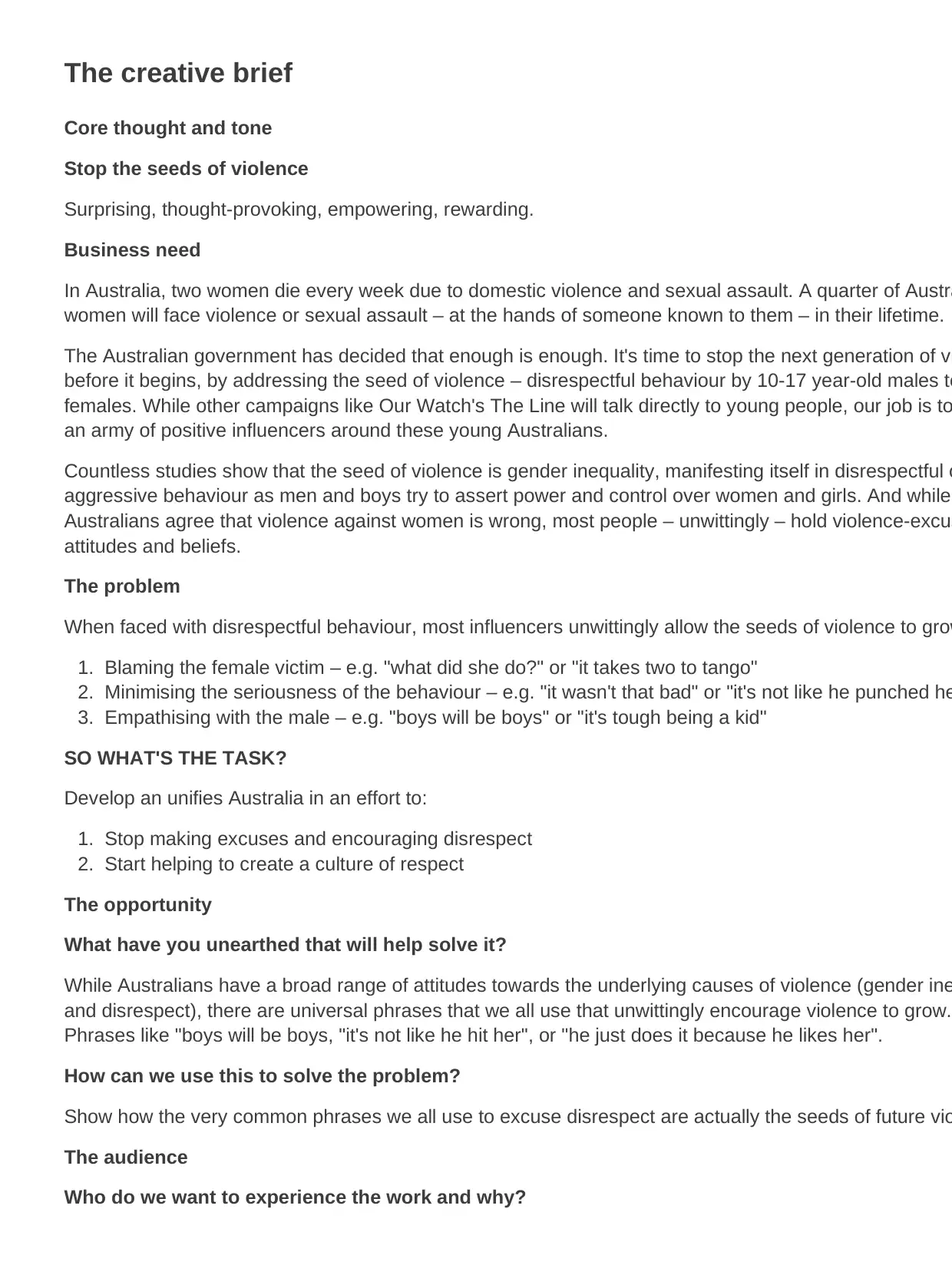
The creative brief
Core thought and tone
Stop the seeds of violence
Surprising, thought-provoking, empowering, rewarding.
Business need
In Australia, two women die every week due to domestic violence and sexual assault. A quarter of Austra
women will face violence or sexual assault – at the hands of someone known to them – in their lifetime.
The Australian government has decided that enough is enough. It's time to stop the next generation of vi
before it begins, by addressing the seed of violence – disrespectful behaviour by 10-17 year-old males to
females. While other campaigns like Our Watch's The Line will talk directly to young people, our job is to
an army of positive influencers around these young Australians.
Countless studies show that the seed of violence is gender inequality, manifesting itself in disrespectful o
aggressive behaviour as men and boys try to assert power and control over women and girls. And while
Australians agree that violence against women is wrong, most people – unwittingly – hold violence-excus
attitudes and beliefs.
The problem
When faced with disrespectful behaviour, most influencers unwittingly allow the seeds of violence to grow
1. Blaming the female victim – e.g. "what did she do?" or "it takes two to tango"
2. Minimising the seriousness of the behaviour – e.g. "it wasn't that bad" or "it's not like he punched he
3. Empathising with the male – e.g. "boys will be boys" or "it's tough being a kid"
SO WHAT'S THE TASK?
Develop an unifies Australia in an effort to:
1. Stop making excuses and encouraging disrespect
2. Start helping to create a culture of respect
The opportunity
What have you unearthed that will help solve it?
While Australians have a broad range of attitudes towards the underlying causes of violence (gender ine
and disrespect), there are universal phrases that we all use that unwittingly encourage violence to grow.
Phrases like "boys will be boys, "it's not like he hit her", or "he just does it because he likes her".
How can we use this to solve the problem?
Show how the very common phrases we all use to excuse disrespect are actually the seeds of future vio
The audience
Who do we want to experience the work and why?
Core thought and tone
Stop the seeds of violence
Surprising, thought-provoking, empowering, rewarding.
Business need
In Australia, two women die every week due to domestic violence and sexual assault. A quarter of Austra
women will face violence or sexual assault – at the hands of someone known to them – in their lifetime.
The Australian government has decided that enough is enough. It's time to stop the next generation of vi
before it begins, by addressing the seed of violence – disrespectful behaviour by 10-17 year-old males to
females. While other campaigns like Our Watch's The Line will talk directly to young people, our job is to
an army of positive influencers around these young Australians.
Countless studies show that the seed of violence is gender inequality, manifesting itself in disrespectful o
aggressive behaviour as men and boys try to assert power and control over women and girls. And while
Australians agree that violence against women is wrong, most people – unwittingly – hold violence-excus
attitudes and beliefs.
The problem
When faced with disrespectful behaviour, most influencers unwittingly allow the seeds of violence to grow
1. Blaming the female victim – e.g. "what did she do?" or "it takes two to tango"
2. Minimising the seriousness of the behaviour – e.g. "it wasn't that bad" or "it's not like he punched he
3. Empathising with the male – e.g. "boys will be boys" or "it's tough being a kid"
SO WHAT'S THE TASK?
Develop an unifies Australia in an effort to:
1. Stop making excuses and encouraging disrespect
2. Start helping to create a culture of respect
The opportunity
What have you unearthed that will help solve it?
While Australians have a broad range of attitudes towards the underlying causes of violence (gender ine
and disrespect), there are universal phrases that we all use that unwittingly encourage violence to grow.
Phrases like "boys will be boys, "it's not like he hit her", or "he just does it because he likes her".
How can we use this to solve the problem?
Show how the very common phrases we all use to excuse disrespect are actually the seeds of future vio
The audience
Who do we want to experience the work and why?
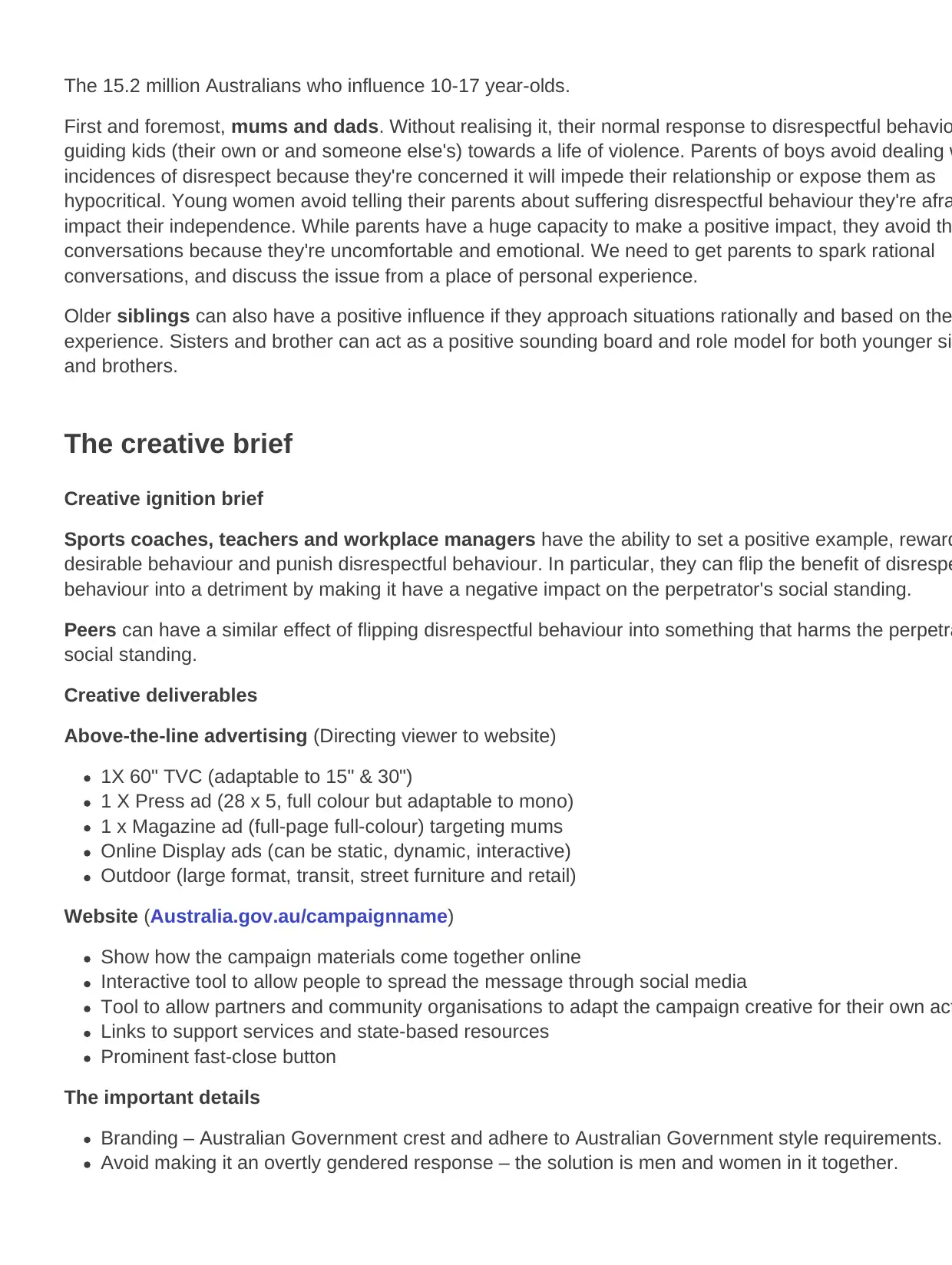
The 15.2 million Australians who influence 10-17 year-olds.
First and foremost, mums and dads. Without realising it, their normal response to disrespectful behavio
guiding kids (their own or and someone else's) towards a life of violence. Parents of boys avoid dealing w
incidences of disrespect because they're concerned it will impede their relationship or expose them as
hypocritical. Young women avoid telling their parents about suffering disrespectful behaviour they're afra
impact their independence. While parents have a huge capacity to make a positive impact, they avoid th
conversations because they're uncomfortable and emotional. We need to get parents to spark rational
conversations, and discuss the issue from a place of personal experience.
Older siblings can also have a positive influence if they approach situations rationally and based on the
experience. Sisters and brother can act as a positive sounding board and role model for both younger si
and brothers.
The creative brief
Creative ignition brief
Sports coaches, teachers and workplace managers have the ability to set a positive example, reward
desirable behaviour and punish disrespectful behaviour. In particular, they can flip the benefit of disrespe
behaviour into a detriment by making it have a negative impact on the perpetrator's social standing.
Peers can have a similar effect of flipping disrespectful behaviour into something that harms the perpetra
social standing.
Creative deliverables
Above-the-line advertising (Directing viewer to website)
1X 60" TVC (adaptable to 15" & 30")
1 X Press ad (28 x 5, full colour but adaptable to mono)
1 x Magazine ad (full-page full-colour) targeting mums
Online Display ads (can be static, dynamic, interactive)
Outdoor (large format, transit, street furniture and retail)
Website (Australia.gov.au/campaignname)
Show how the campaign materials come together online
Interactive tool to allow people to spread the message through social media
Tool to allow partners and community organisations to adapt the campaign creative for their own act
Links to support services and state-based resources
Prominent fast-close button
The important details
Branding – Australian Government crest and adhere to Australian Government style requirements.
Avoid making it an overtly gendered response – the solution is men and women in it together.
First and foremost, mums and dads. Without realising it, their normal response to disrespectful behavio
guiding kids (their own or and someone else's) towards a life of violence. Parents of boys avoid dealing w
incidences of disrespect because they're concerned it will impede their relationship or expose them as
hypocritical. Young women avoid telling their parents about suffering disrespectful behaviour they're afra
impact their independence. While parents have a huge capacity to make a positive impact, they avoid th
conversations because they're uncomfortable and emotional. We need to get parents to spark rational
conversations, and discuss the issue from a place of personal experience.
Older siblings can also have a positive influence if they approach situations rationally and based on the
experience. Sisters and brother can act as a positive sounding board and role model for both younger si
and brothers.
The creative brief
Creative ignition brief
Sports coaches, teachers and workplace managers have the ability to set a positive example, reward
desirable behaviour and punish disrespectful behaviour. In particular, they can flip the benefit of disrespe
behaviour into a detriment by making it have a negative impact on the perpetrator's social standing.
Peers can have a similar effect of flipping disrespectful behaviour into something that harms the perpetra
social standing.
Creative deliverables
Above-the-line advertising (Directing viewer to website)
1X 60" TVC (adaptable to 15" & 30")
1 X Press ad (28 x 5, full colour but adaptable to mono)
1 x Magazine ad (full-page full-colour) targeting mums
Online Display ads (can be static, dynamic, interactive)
Outdoor (large format, transit, street furniture and retail)
Website (Australia.gov.au/campaignname)
Show how the campaign materials come together online
Interactive tool to allow people to spread the message through social media
Tool to allow partners and community organisations to adapt the campaign creative for their own act
Links to support services and state-based resources
Prominent fast-close button
The important details
Branding – Australian Government crest and adhere to Australian Government style requirements.
Avoid making it an overtly gendered response – the solution is men and women in it together.
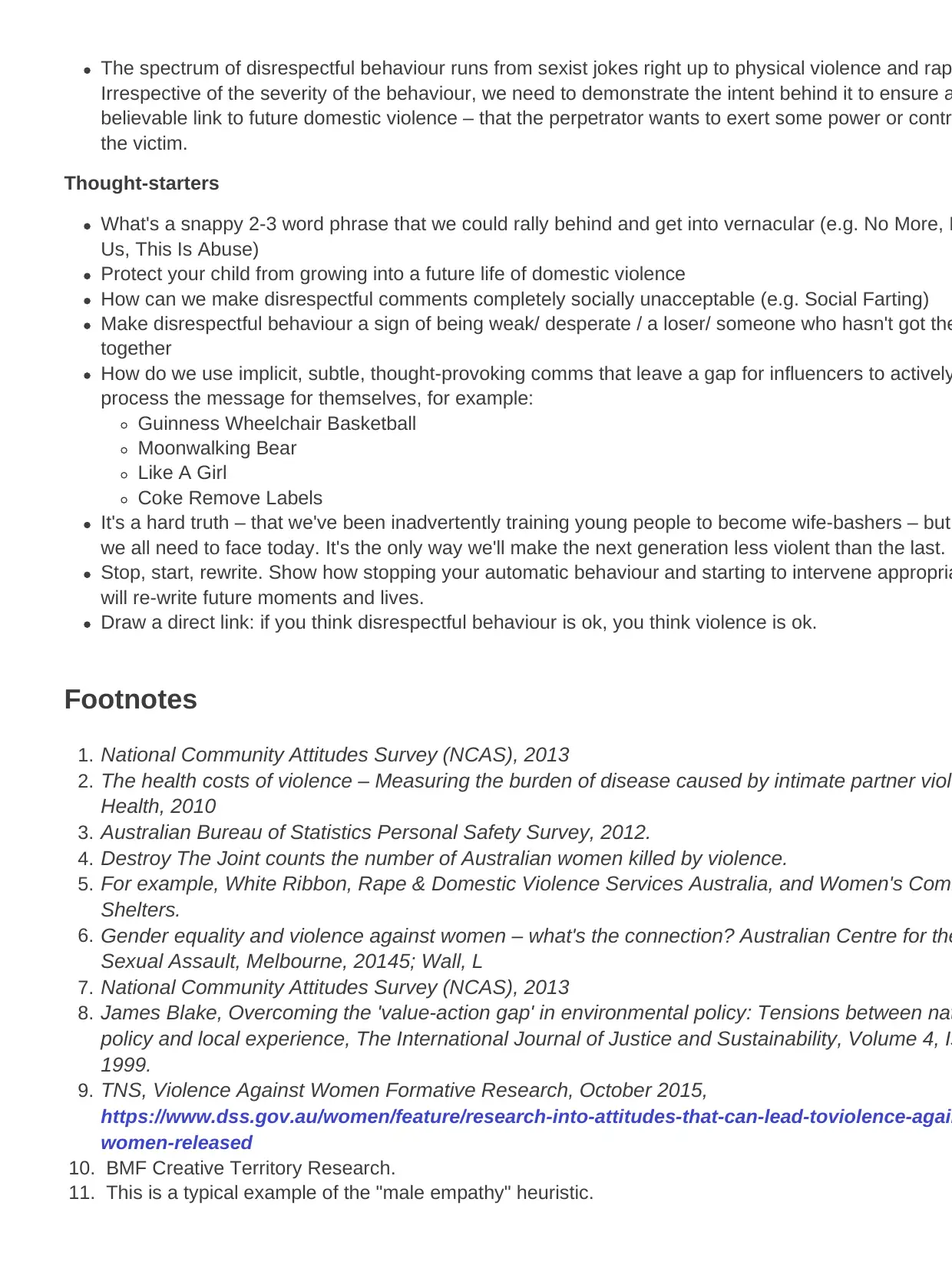
The spectrum of disrespectful behaviour runs from sexist jokes right up to physical violence and rap
Irrespective of the severity of the behaviour, we need to demonstrate the intent behind it to ensure a
believable link to future domestic violence – that the perpetrator wants to exert some power or contr
the victim.
Thought-starters
What's a snappy 2-3 word phrase that we could rally behind and get into vernacular (e.g. No More, I
Us, This Is Abuse)
Protect your child from growing into a future life of domestic violence
How can we make disrespectful comments completely socially unacceptable (e.g. Social Farting)
Make disrespectful behaviour a sign of being weak/ desperate / a loser/ someone who hasn't got the
together
How do we use implicit, subtle, thought-provoking comms that leave a gap for influencers to actively
process the message for themselves, for example:
Guinness Wheelchair Basketball
Moonwalking Bear
Like A Girl
Coke Remove Labels
It's a hard truth – that we've been inadvertently training young people to become wife-bashers – but
we all need to face today. It's the only way we'll make the next generation less violent than the last.
Stop, start, rewrite. Show how stopping your automatic behaviour and starting to intervene appropria
will re-write future moments and lives.
Draw a direct link: if you think disrespectful behaviour is ok, you think violence is ok.
Footnotes
1. National Community Attitudes Survey (NCAS), 2013
2. The health costs of violence – Measuring the burden of disease caused by intimate partner viole
Health, 2010
3. Australian Bureau of Statistics Personal Safety Survey, 2012.
4. Destroy The Joint counts the number of Australian women killed by violence.
5. For example, White Ribbon, Rape & Domestic Violence Services Australia, and Women's Comm
Shelters.
6. Gender equality and violence against women – what's the connection? Australian Centre for the
Sexual Assault, Melbourne, 20145; Wall, L
7. National Community Attitudes Survey (NCAS), 2013
8. James Blake, Overcoming the 'value-action gap' in environmental policy: Tensions between nat
policy and local experience, The International Journal of Justice and Sustainability, Volume 4, Is
1999.
9. TNS, Violence Against Women Formative Research, October 2015,
https://www.dss.gov.au/women/feature/research-into-attitudes-that-can-lead-toviolence-again
women-released
10. BMF Creative Territory Research.
11. This is a typical example of the "male empathy" heuristic.
Irrespective of the severity of the behaviour, we need to demonstrate the intent behind it to ensure a
believable link to future domestic violence – that the perpetrator wants to exert some power or contr
the victim.
Thought-starters
What's a snappy 2-3 word phrase that we could rally behind and get into vernacular (e.g. No More, I
Us, This Is Abuse)
Protect your child from growing into a future life of domestic violence
How can we make disrespectful comments completely socially unacceptable (e.g. Social Farting)
Make disrespectful behaviour a sign of being weak/ desperate / a loser/ someone who hasn't got the
together
How do we use implicit, subtle, thought-provoking comms that leave a gap for influencers to actively
process the message for themselves, for example:
Guinness Wheelchair Basketball
Moonwalking Bear
Like A Girl
Coke Remove Labels
It's a hard truth – that we've been inadvertently training young people to become wife-bashers – but
we all need to face today. It's the only way we'll make the next generation less violent than the last.
Stop, start, rewrite. Show how stopping your automatic behaviour and starting to intervene appropria
will re-write future moments and lives.
Draw a direct link: if you think disrespectful behaviour is ok, you think violence is ok.
Footnotes
1. National Community Attitudes Survey (NCAS), 2013
2. The health costs of violence – Measuring the burden of disease caused by intimate partner viole
Health, 2010
3. Australian Bureau of Statistics Personal Safety Survey, 2012.
4. Destroy The Joint counts the number of Australian women killed by violence.
5. For example, White Ribbon, Rape & Domestic Violence Services Australia, and Women's Comm
Shelters.
6. Gender equality and violence against women – what's the connection? Australian Centre for the
Sexual Assault, Melbourne, 20145; Wall, L
7. National Community Attitudes Survey (NCAS), 2013
8. James Blake, Overcoming the 'value-action gap' in environmental policy: Tensions between nat
policy and local experience, The International Journal of Justice and Sustainability, Volume 4, Is
1999.
9. TNS, Violence Against Women Formative Research, October 2015,
https://www.dss.gov.au/women/feature/research-into-attitudes-that-can-lead-toviolence-again
women-released
10. BMF Creative Territory Research.
11. This is a typical example of the "male empathy" heuristic.
Secure Best Marks with AI Grader
Need help grading? Try our AI Grader for instant feedback on your assignments.
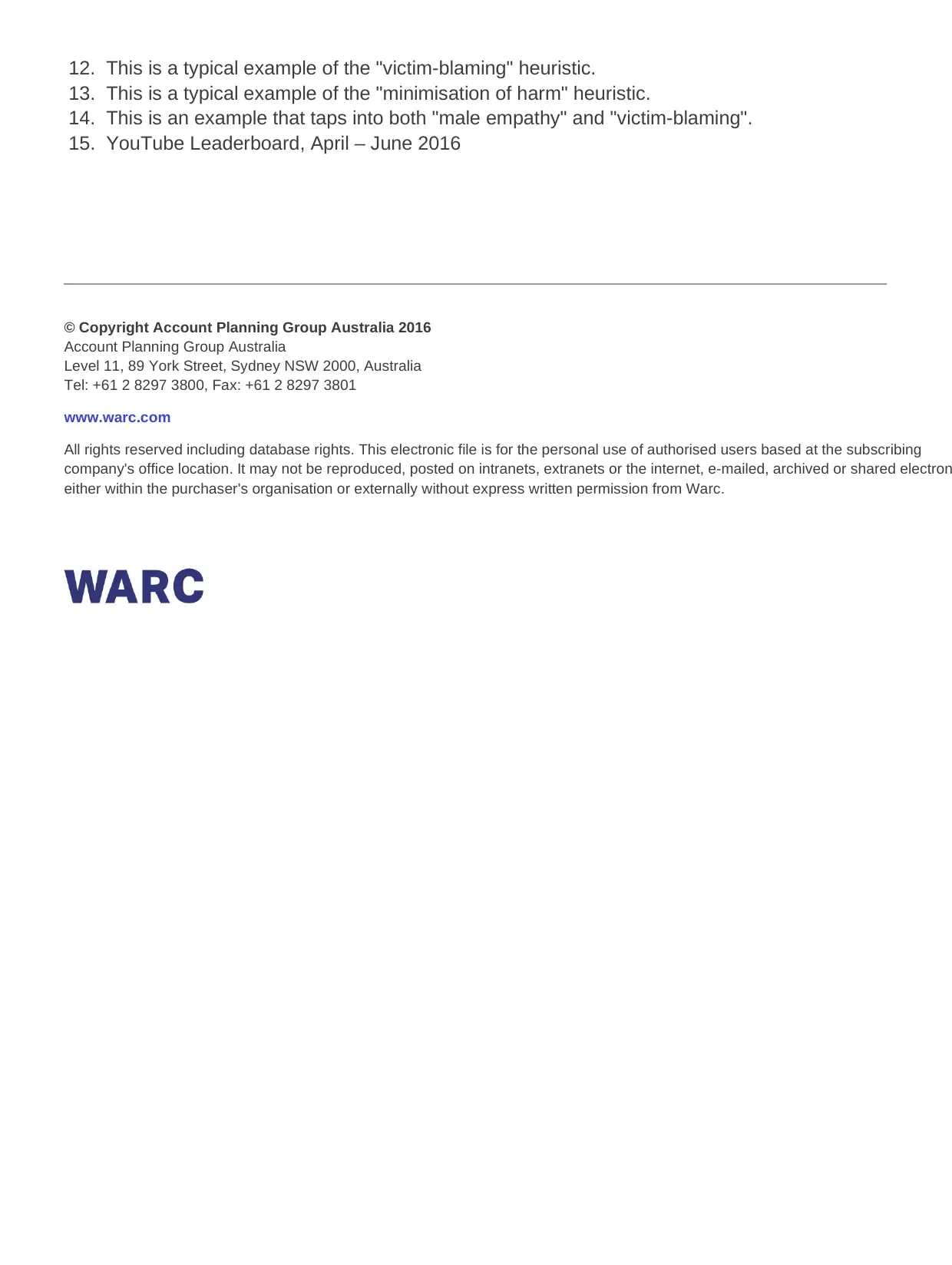
12. This is a typical example of the "victim-blaming" heuristic.
13. This is a typical example of the "minimisation of harm" heuristic.
14. This is an example that taps into both "male empathy" and "victim-blaming".
15. YouTube Leaderboard, April – June 2016
© Copyright Account Planning Group Australia 2016
Account Planning Group Australia
Level 11, 89 York Street, Sydney NSW 2000, Australia
Tel: +61 2 8297 3800, Fax: +61 2 8297 3801
www.warc.com
All rights reserved including database rights. This electronic file is for the personal use of authorised users based at the subscribing
company's office location. It may not be reproduced, posted on intranets, extranets or the internet, e-mailed, archived or shared electron
either within the purchaser's organisation or externally without express written permission from Warc.
13. This is a typical example of the "minimisation of harm" heuristic.
14. This is an example that taps into both "male empathy" and "victim-blaming".
15. YouTube Leaderboard, April – June 2016
© Copyright Account Planning Group Australia 2016
Account Planning Group Australia
Level 11, 89 York Street, Sydney NSW 2000, Australia
Tel: +61 2 8297 3800, Fax: +61 2 8297 3801
www.warc.com
All rights reserved including database rights. This electronic file is for the personal use of authorised users based at the subscribing
company's office location. It may not be reproduced, posted on intranets, extranets or the internet, e-mailed, archived or shared electron
either within the purchaser's organisation or externally without express written permission from Warc.
1 out of 11
Related Documents
Your All-in-One AI-Powered Toolkit for Academic Success.
+13062052269
info@desklib.com
Available 24*7 on WhatsApp / Email
![[object Object]](/_next/static/media/star-bottom.7253800d.svg)
Unlock your academic potential
© 2024 | Zucol Services PVT LTD | All rights reserved.



